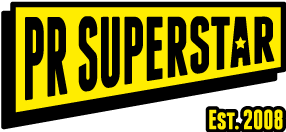
How to Use Twitter for PR
Let’s look at how to use Twitter for PR.
Twitter, or X as it’s now officially called, has come a long way from its humble beginnings in 2006 as a 140-character microblogging site.
Today, the Elon Musk-owned platform is the fifth most visited website in the world, boasting more than 528 million monthly users. And, despite the tech billionaire’s ‘demon-like outbursts’ and controversial policy changes, it’s set to top 652.23 million users by 2028.
This shows that, contrary to claims that ‘Twitter is dying’, the platform is very much alive and kicking. And it’s teeming with PR opportunities for savvy brands.
Ready for a crash course in Twitter PR? Let’s get started.
Twitter: a PR powerhouse
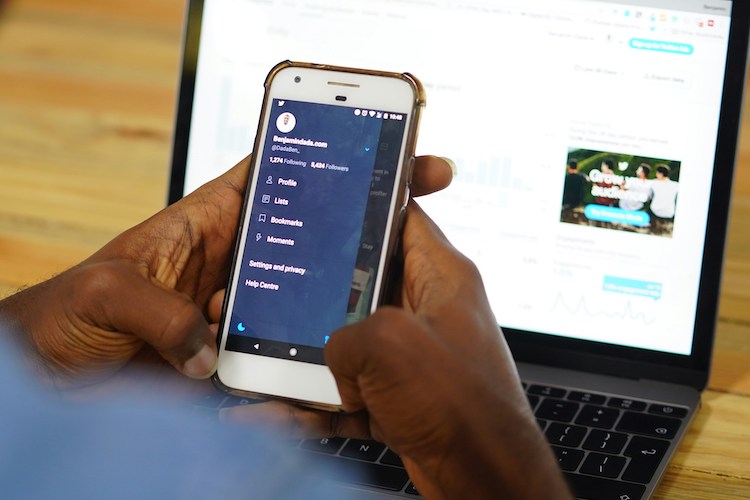
In the weird and wonderful world of social media, Twitter is an intriguing beast.
In terms of revenue and user numbers, it’s dwarfed by Facebook and Instagram. But its influence is unrivalled.
As James O’Malley says in a Reader’s Digest article, ‘what [Twitter/X] lacks in revenue, size, and growth potential, it makes up for in a much harder to define way. It carries enormous cultural power, and has an unrivalled ability to shape the news we read, the content we consume, and the culture we live in.’
This is evident from the crucial role it plays in breaking global news stories, shaping political discourse and facilitating social movements such as #BlackLivesMatter.
But why is Twitter so influential? In a word, its clientele.
To quote O’Malley, ‘Twitter is the place where the most powerful and influential people like to hang out.’
These ‘powerful people’ include celebrities, politicians, and the most influential group of all: journalists.
According to Muck Rack, 90% of reporters are active on the platform. And they scour it daily to break stories and find the latest scoop.
As a result, ‘Twitter is the most popular social platform for news and current events’.
What does this mean for brands?
If you’ve got something newsworthy to say, Twitter/X is the place to say it.
However, grabbing the attention of journalists and prospects isn’t easy. With more than 118 million businesses vying for attention, you need to stand out to get noticed.
Enter Twitter PR.
The benefits of Twitter for public relations

When it comes to digital PR, Twitter trumps the other social media platforms in three areas.
1. Media Relations
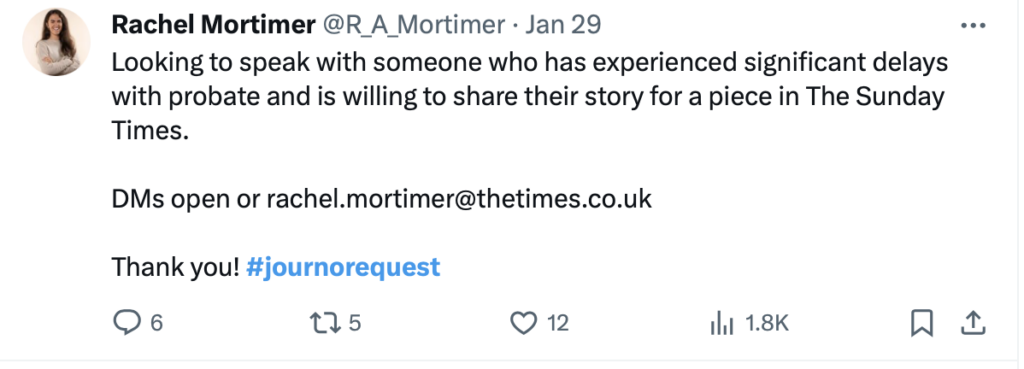

Media relations is a subset of public relations that focuses on ‘building relationships between brands and the media’.
Considering Twitter is the social media platform of choice for journalists, it’s the ideal place to focus your social media PR efforts.
But how can you make friends with the media? Here are two suggestions for starters.
Stroke their egos
You know the saying, ‘flattery will get you everywhere?’ It applies here.
As freelance journalist Sally Percy says in a blog post, ‘we journalists have egos … we like to think that our self-indulgent musings on Twitter are informing/amusing someone somewhere in the world’.
Here are a few surefire ways to build relationships with journalists.:
- Follow their accounts, like their tweets, and make insightful comments (when you have something of value to add).
- Respond to their questions. As Sally Percy says, ‘[reporters] are genuinely interested in what you think. Our job is to know what’s happening out there on the ground. If you don’t tell us, no one will. If you see a journalist ask a question on Twitter and you have a view, what are waiting for? Tweet right back.’
- Share relevant tweets/articles with your audience, adding your unique take on the story to showcase your expertise. And don’t forget to tag the reporter.
Tip: Don’t overdo any of the above. Your aim is to ingratiate, not irritate.
Respond to media requests
Thousands of reporters use the #JournoRequest hashtag to source quotes, expert opinions, and interviews for stories.
Responding to requests is a great way to get on their radar and bag some easy coverage.
If your response meets their requirements and you prove yourself to be a credible source, the chances are the reporter will call on you again.
A word of warning: If you fire off an irrelevant response, your email will get binned, and you’ll blow your chances of building a relationship with a key media contact.
Only respond if your business fits the criteria.
For more on using Twitter for media relations, read: Why Twitter remains an important media relations tool for business.
2. Crisis management
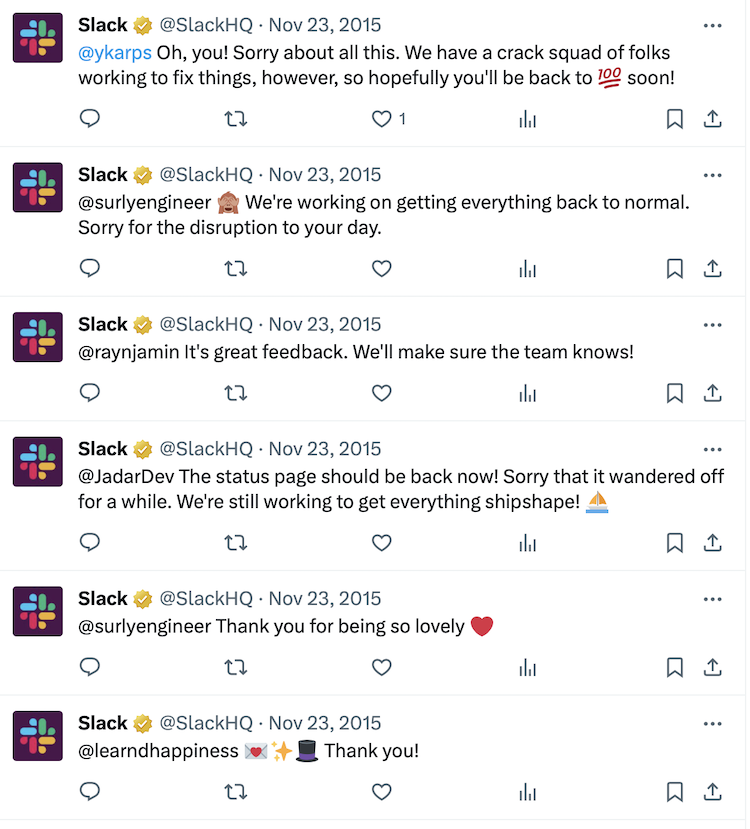
PR crises can strike any brand, at any time. If the worst happens, you need to respond quickly to keep your reputation intact.
Twitter’s real-time capabilities make it a potent tool for speedy crisis comms, as this example from Slack demonstrates.
In 2015, the workplace messaging app suffered a widespread service outage, leaving 60,000+ businesses unable to send or receive messages and files for several hours in the middle of a working day.
Within minutes, thousands of users took to Twitter to express their frustration and poke fun at the brand, using the hashtag #slackdown.
No slacking in the response
Negative PR was the last thing the fledgling tech brand needed. But the team was ready. As soon as they caught wind of the problem, they acknowledged it in a tweet. And proceeded to post updates every 30-minutes to keep users informed of the progress they were making to restore access.
And that’s not all. Once the issue was fixed, the brand sent personalised tweets to every user that complained about or commented on the shortage, of which there were more than 2,300.
Happy slackers
Slack’s efforts paid dividends. Managing the crisis on Twitter enabled the brand to share critical updates in real-time. In doing so, they alleviated users concerns and kept control of the narrative.
And, taking the time to respond to individual complaints was a stroke of PR genius. As well as placating disgruntled users, it saw the brand gain over 3,300 new followers and a ton of positive coverage.
Kudos to Slack for turning a PR disaster into a success story.
Want to know what do when a crisis strikes? Read: Crisis Management in Public Relations
3. Customer service
Want to turn your customers into raving brand ambassadors? There’s one surefire way to do it: deliver exceptional customer service. And Twitter is the place to do it, for three reasons.
It’s fast
When it comes to customer service on social media, speed is of the essence. Research by Twitter found that, ‘75% of customers expect a quick response, ideally within 15 minutes’.
As we established earlier, Twitter excels at real-time communication, making it the perfect platform to provide quick, effective support.
Customers value it
Twitter’s research also revealed that good customer care on the platform can boost brand sentiment by 58%. And, as Async Labs says in a blog post, ‘brands with strong positive sentiment enjoy higher levels of customer loyalty.’
Who doesn’t want that?
Lack of competition
Just 32% of brands use Twitter for customer service. This provides you with a prime opportunity to shine. Get it really right and you could nab a spot in the record books, like Xbox. The Microsoft-owned gaming brand is renowned for its exceptional customer service on Twitter. And it’s all down to the brand’s dedicated Twitter customer service team, the ‘Elite Tweet Fleet’.
In 2010, the Tweet Fleet proved their customer service chops by responding to 5,000 customer queries in one week, with an average response time of 2 minutes and 42 seconds. The herculean effort resulted in a ‘most responsive corporate Twitter account’ Guinness World Record for @XboxSupport.
PR doesn’t get much better than that.
Want to level up your customer service game on Twitter? Here are some tips straight from the horse’s mouth.
Leveraging the Twittersphere

Those are the benefits of using Twitter as a PR tool. But how can you harness the power of Twitter for public relations?
Here are some tips.
Post frequently
Twitter is a fast-moving platform. More than 500 million tweets are posted daily. As a result, the average lifespan of a tweet is 15-20 minutes. To put it in context, the average shelf life of a Facebook post is five hours. For Instagram, it’s 48 hours.
To show up in Twitter’s busy feed, you need to post regularly. Hootsuite recommends 2-3 tweets a day, but, as with anything else in life, quality trumps quantity.
To resonate with your audience, your content needs to be unique and engaging, which brings me onto the next point.
Focus on engagement
Engagement is key to success on Twitter. As digital marketing agency Vserve explains in an article, ‘the Twitter algorithm considers engagement metrics like likes, retweets, and comments to identify popular tweets. Tweets with higher engagement have a better chance of appearing on users’ timelines.’
Okay, but how can you drive engagement?
Try the following.
Make your content interactive
According to Mediafly, interactive content sees 52.6% more engagement than static content on Twitter. Interactive content can take various forms. For example:
1. Twitter polls
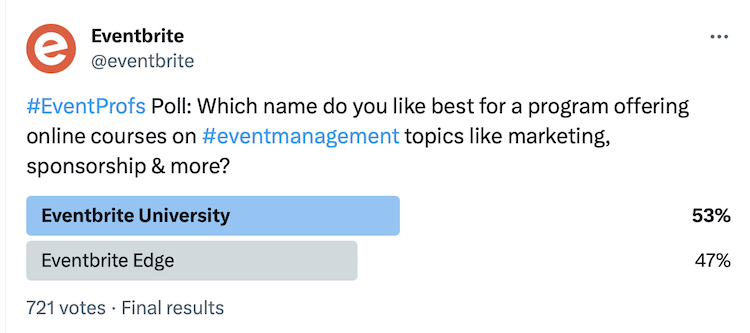
Polls are a quick and efficient way to get real-time feedback from your audience, you can use polls to find out what your followers think about your brand, products, or a topic relevant to your industry.
2. Twitter Spaces
Spaces are live audio chat rooms. And they offer a unique opportunity to leverage the power of audio to engage with your audience.
Thirteen people can speak in a Space at a time, and the conversations can be accessed by anyone, whether they have a Twitter account or not.
Here are a few ways you can utilise Spaces for PR.
Generate buzz
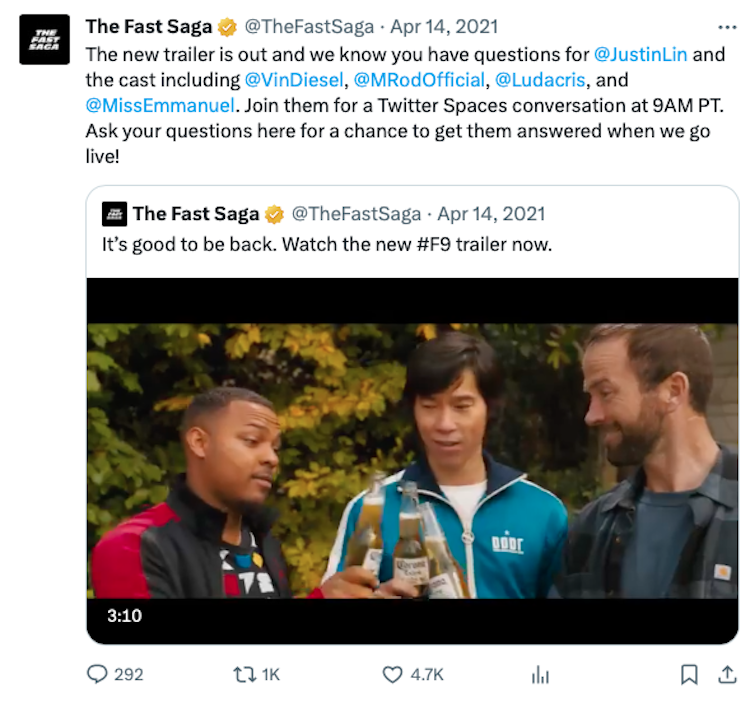
Launching a new product? Use Spaces to generate buzz.
This is what the folk behind The Fast and Furious movie franchise did to promote ‘F9: The Fast Saga.’ After the trailer dropped, @TheFastSaga held a Space with director Justin Lin and actors Vin Diesel, Michelle Rodriguez, and Ludacris.
They used the Space to connect with fans, answer questions, and share ‘behind the scenes’ gossip.
Build brand authority
Forbes describes brand authority as ‘the degree to which your brand is seen as a leader or source of expert information within your niche’. The options for building authority on Spaces are endless. Think Q&A sessions, panel discussions, and interviews with industry experts.
Or you could roll them all into one event, like Pure Earth did in 2022. The American environmental charity teamed up with Consumer Reports, Clean Label Project, The Center for Global Development, and Global Alliance on Health and Pollution for a Spaces discussion to raise awareness of the health risks posed by pollution.
The experts debated the issue, discussed solutions, offered listeners advice, and answered their questions. It was a shrewd move by Pure Earth. Joining forces with industry stalwarts was a great way to magnify the problem and get the brand in front of new audiences.
Shout about your accomplishments
In 2021, Twitter launched a competition to identify the ‘best tweeting business’ on the platform. The marketing team pitted brands from different categories against each other and asked users to vote for a winner of each match-up.
The two brands with the most votes then went head-to-head to win the ‘best of tweets’ crown. With 568,750 votes, Microsoft’s gaming arm Xbox came out on top. Following its victory, Xbox teamed up with AdAge for a Space to celebrate the win and reveal the secrets behind their tweeting prowess.
A clever way to showcase their expertise and nab coverage in a prominent publication. Ready to amplify your voice on Spaces? This guide will tell you everything you need to know.
3. Jump on trending hashtags
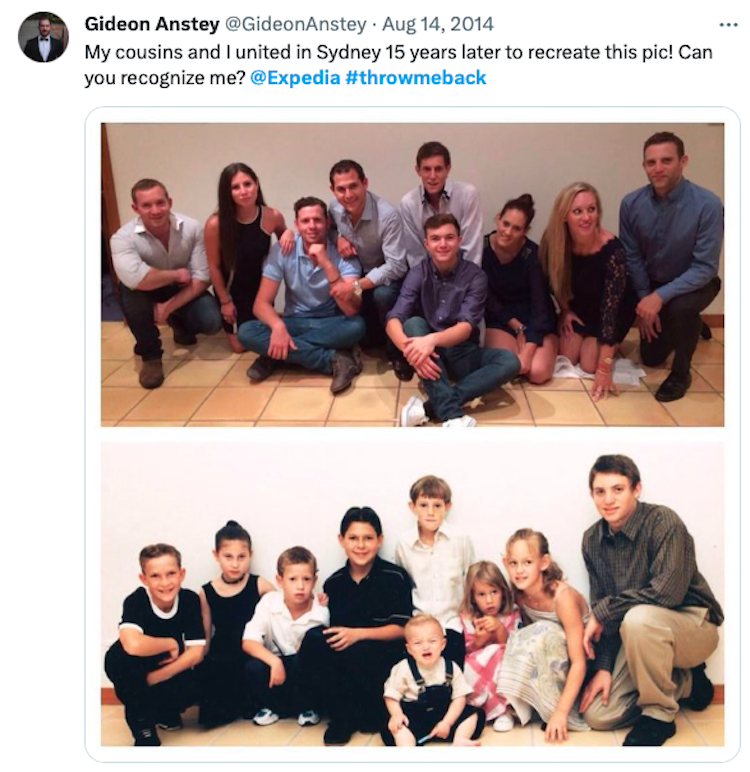
‘Trending’ hashtags are the most popular hashtags on Twitter at a given time.
Riding the wave of a trending hashtag is a clever way to stay relevant, expose your brand to new users, and skyrocket engagement. Just ask Expedia.
In 2014, the online travel agency capitalised on the then trending #throwbackthursday and #tbt hashtags to launch a summer campaign. With its #throwmeback campaign, the brand encouraged users to recreate their favourite holiday photos and post them to Twitter and Instagram, using the trending hashtags and #throwmeback.
Over the course of the campaign, ten entrants were picked to return to the destination in their photo for an all-expenses paid holiday. What’s not to like? The campaign was a resounding success. It attracted 5,000 submissions, 300,000 total engagements, and five million impressions. And it garnered Expedia a ton of user-generated content to boot.
Tip: Twitter trends are short-lived. If you go down this route, you need to act quickly to reap the rewards.
You can get ahead of the game by monitoring trending hashtags on the ‘explore’ section of your Twitter homepage. Want to level up your hashtag game? Sprout Social takes a deep dive in this article.
Final word on using Twitter for PR
Twitter is a hotbed of PR opportunities. If you’re not taking advantage, it’s time to level up your Twitter PR game and enjoy the payoff.
